EXHIBIT 99.1
Published on January 11, 2022
Exhibit 99.1
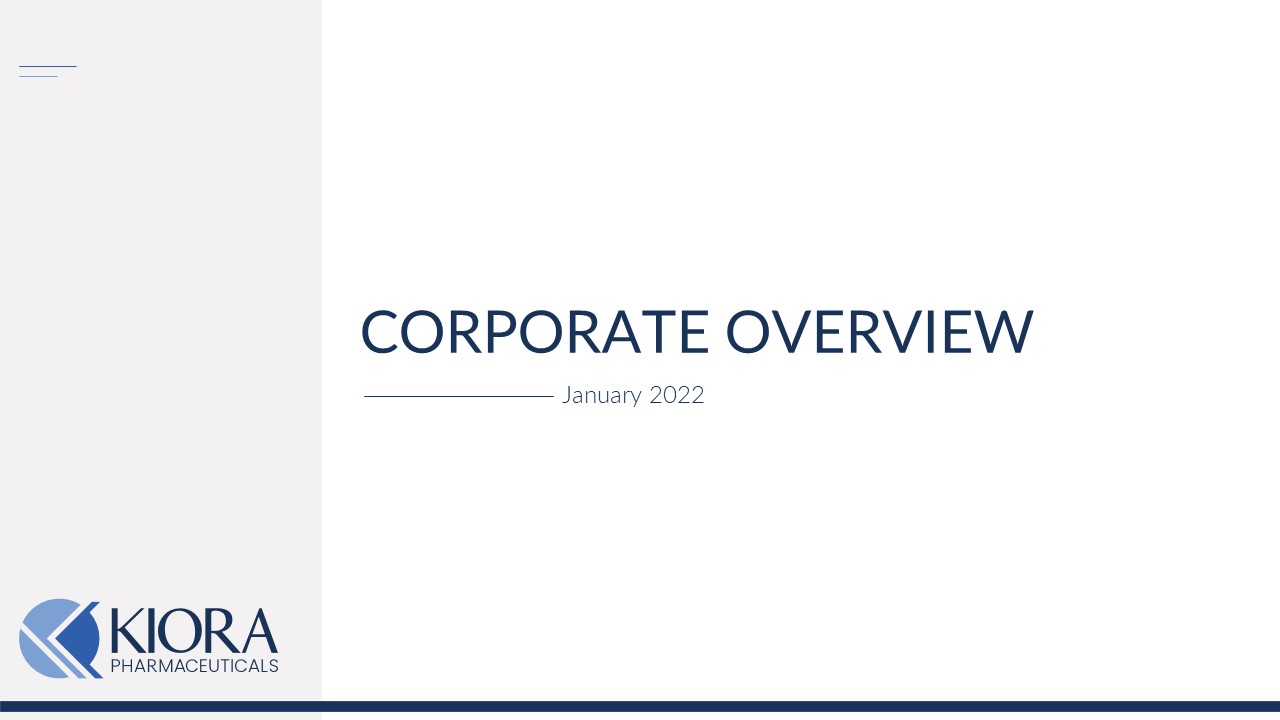
CORPORATE OVERVIEW January 2022

2 Forward Looking Statements Some of the statements in this press release are “forward - looking” and are made pursuant to the safe harbor provision of the Private Securities Litigation Reform Act of 1995 . These “forward - looking” statements include statements relating to, among other things, the development and commercialization efforts and other regulatory or marketing approval efforts pertaining to Kiora’s products, including KIO - 101 , KIO - 201 and KIO - 301 , as well as the success thereof, with such approvals or success may not be obtained or achieved on a timely basis or at all . These statements involve risks and uncertainties that may cause results to differ materially from the statements set forth in this press release, including, among other things, market and other conditions and certain risk factors described under the heading “Risk Factors” contained in Kiora’s Annual Report on Form 10 - K filed with the SEC on March 25 , 2021 or described in Kiora’s other public filings . Kiora’s results may also be affected by factors of which Kiora is not currently aware . The forward - looking statements in this press release speak only as of the date of this press release . Kiora expressly disclaims any obligation or undertaking to release publicly any updates or revisions to such statements to reflect any change in its expectations with regard thereto or any changes in the events, conditions, or circumstances on which any such statement is based, except as required by law .
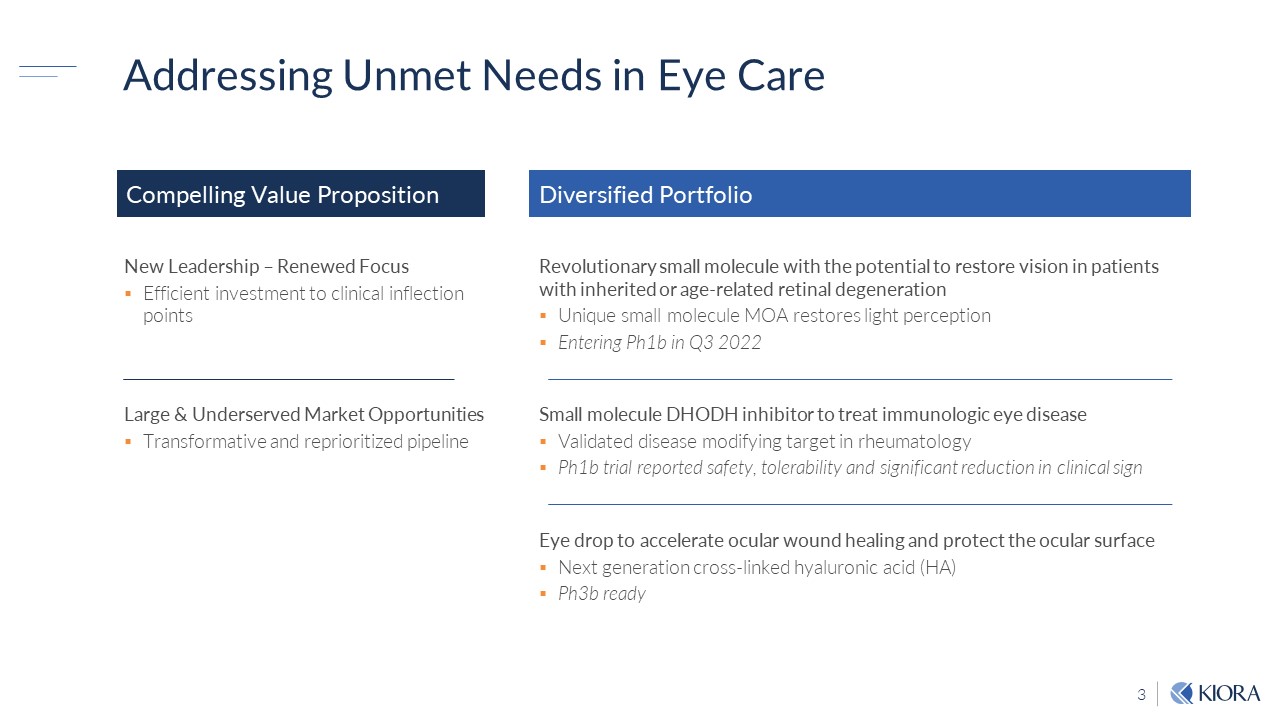
3 Addressing Unmet Needs in Eye Care New Leadership – Renewed Focus ▪ Efficient investment to clinical inflection points Compelling Value Proposition Diversified Portfolio Revolutionary small molecule with the potential to restore vision in patients with inherited or age - related retinal degeneration ▪ Unique small molecule MOA restores light perception ▪ Entering Ph1b in Q3 2022 Eye drop to accelerate ocular wound healing and protect the ocular surface ▪ Next generation cross - linked hyaluronic acid (HA) ▪ Ph3b ready Small molecule DHODH inhibitor to treat immunologic eye disease ▪ Validated disease modifying target in rheumatology ▪ Ph1b trial reported safety, tolerability and significant reduction in clinical sign Large & Underserved Market Opportunities ▪ Transformative and reprioritized pipeline
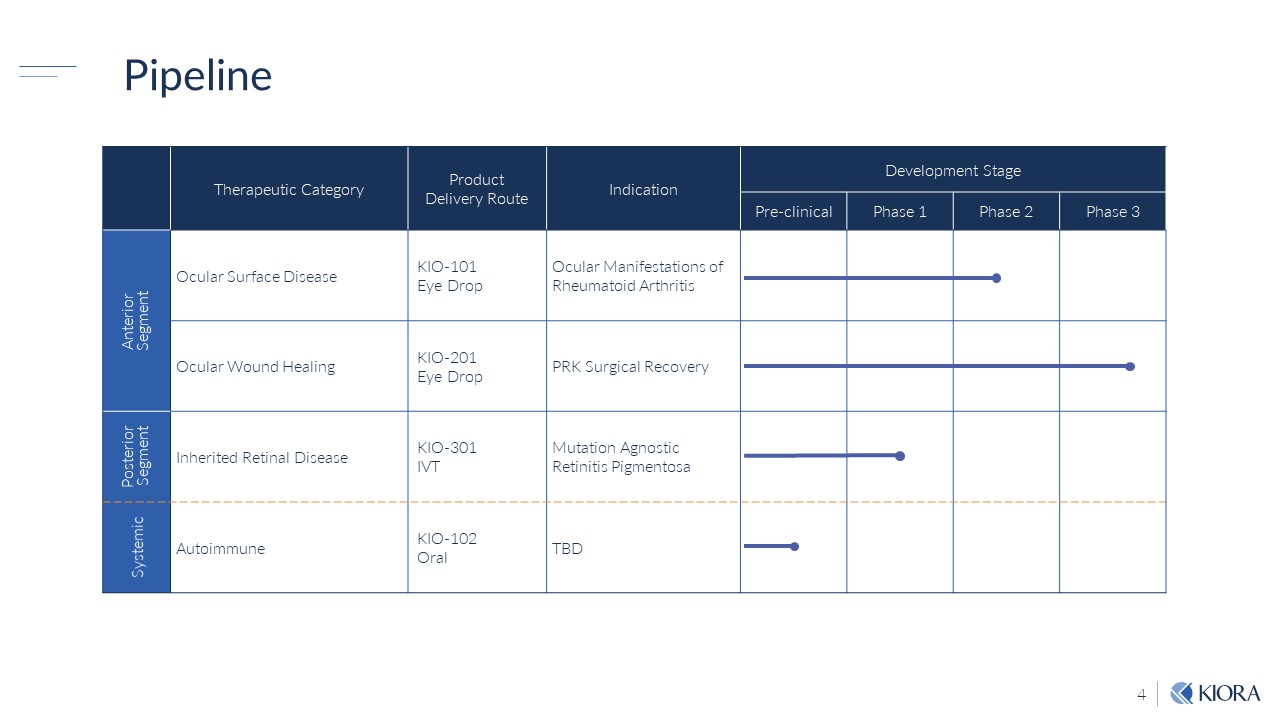
4 Therapeutic Category Product Delivery Route Indication Development Stage Pre - clinical Phase 1 Phase 2 Phase 3 Anterior Segment Ocular Surface Disease KIO - 101 Eye Drop Ocular Manifestations of Rheumatoid Arthritis Ocular Wound Healing KIO - 201 Eye Drop PRK Surgical Recovery Posterior Segment Inherited Retinal Disease KIO - 301 IVT Mutation Agnostic Retinitis Pigmentosa Systemic Autoimmune KIO - 102 Oral TBD Pipeline
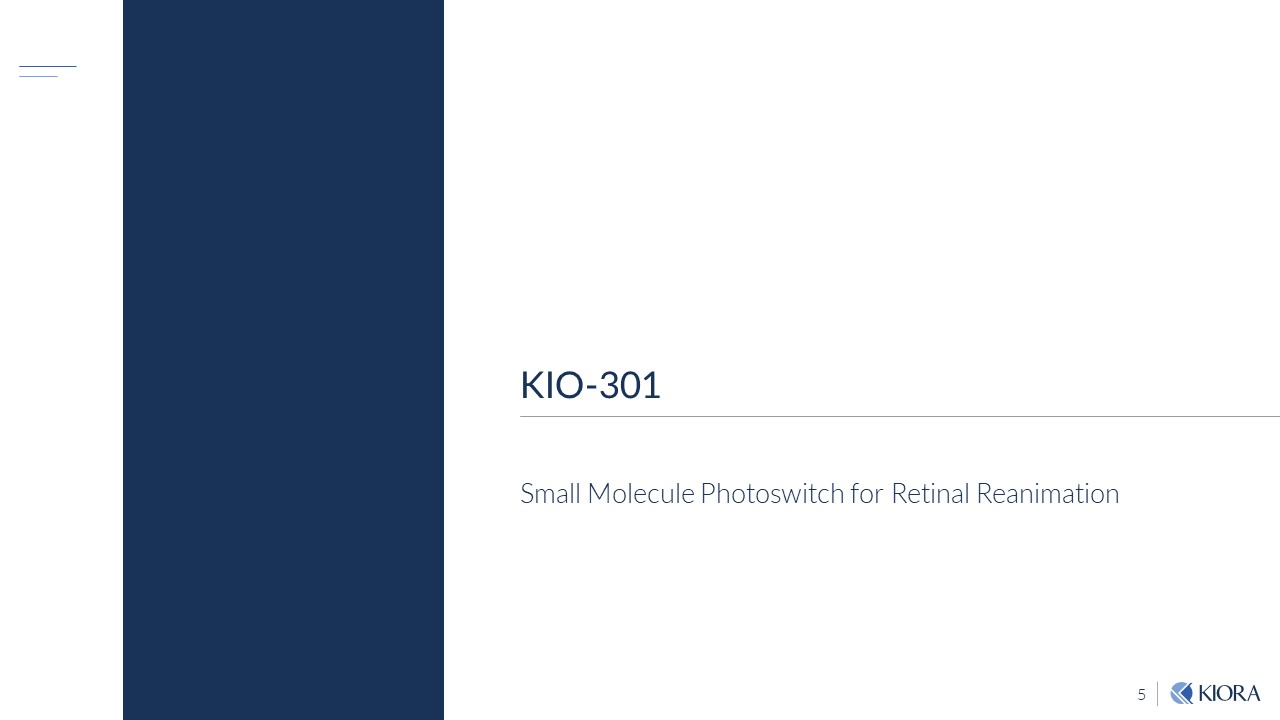
5 KIO - 301 Small Molecule Photoswitch for Retinal Reanimation
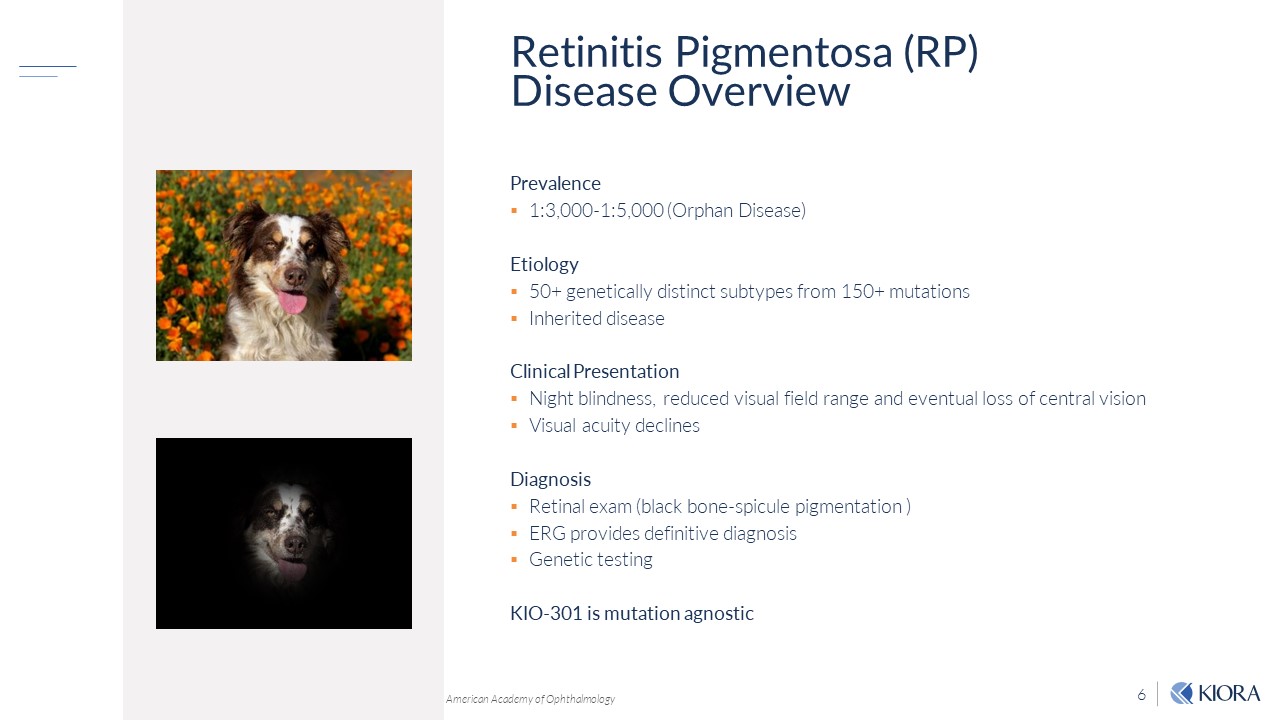
6 Prevalence ▪ 1:3,000 - 1:5,000 (Orphan Disease) Etiology ▪ 50+ genetically distinct subtypes from 150+ mutations ▪ Inherited disease Clinical Presentation ▪ Night blindness, reduced visual field range and eventual loss of central vision ▪ Visual acuity declines Diagnosis ▪ Retinal exam (black bone - spicule pigmentation ) ▪ ERG provides definitive diagnosis ▪ Genetic testing Retinitis Pigmentosa (RP) Disease Overview KIO - 301 is mutation agnostic American Academy of Ophthalmology

7 RP – How Retinal Degeneration Occurs ▪ Normal human retina has about 120 million rods (black & white, night vision, movement) and 6 million cones (color) ▪ Photoreceptors die (rods first, then cones), unable to activate Bipolar cells and Retinal Ganglion Cells (RGCs) ▪ Bipolar cells and RGCs remain intact and retain ability to send signals to the brain Photoreceptors (rods and cones) sense light and pass the signal to special transmitting cells Bipolar cells and RGCs relay signal from rods and cones to the brain, where the image is “processed” RGC Cone Rod Bipolar Cell To the brain (connection intact)
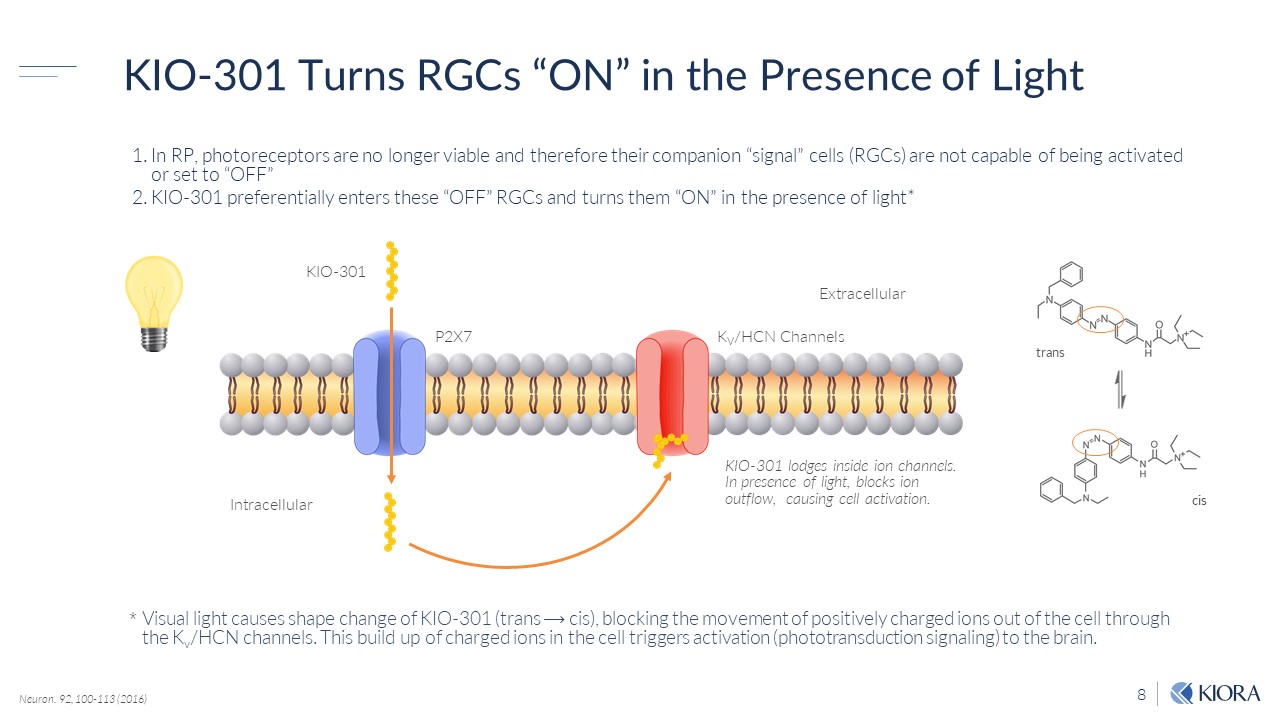
8 KIO - 301 Turns RGCs “ON” in the Presence of Light Neuron. 92, 100 - 113 (2016) trans cis 1. In RP, photoreceptors are no longer viable and therefore their companion “signal” cells (RGCs) are not capable of being activ ate d or set to “OFF” 2. KIO - 301 preferentially enters these “OFF” RGCs and turns them “ON” in the presence of light* * Visual light causes shape change of KIO - 301 (trans ⟶ cis), blocking the movement of positively charged ions out of the cell through the K v /HCN channels. This build up of charged ions in the cell triggers activation (phototransduction signaling) to the brain. Intracellular KIO - 301 P2X7 Extracellular K V /HCN Channels KIO - 301 lodges inside ion channels. In presence of light, blocks ion outflow, causing cell activation.

9 Moonlight 100w Incandescent Light Bulb Cloudy Day Sunlight Light Intensity (photons/cm 2 · sec) KIO - 301: Light Intensity and Wavelength Sci. Rep. 7, 45487 (2017), Banghart, Trauner et al (2008) Wavelength (nm) Light Response Index
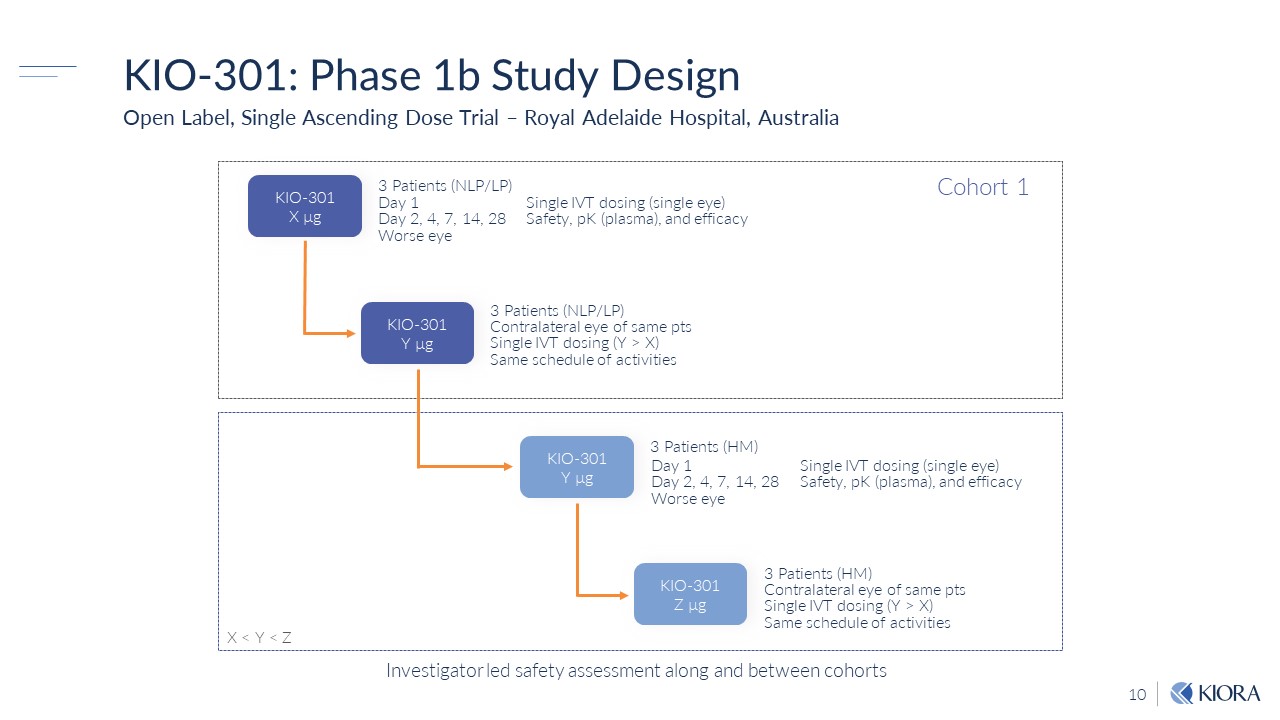
10 Investigator led safety assessment along and between cohorts KIO - 301 X µg KIO - 301 Y µg KIO - 301 Y µg KIO - 301 Z µg 3 Patients (NLP/LP) Contralateral eye of same pts Single IVT dosing (Y > X) Same schedule of activities 3 Patients (HM) 3 Patients (NLP/LP) Cohort 1 X < Y < Z Day 1 Day 2, 4, 7, 14, 28 Worse eye Single IVT dosing (single eye) Safety, pK (plasma), and efficacy Day 1 Day 2, 4, 7, 14, 28 Worse eye Single IVT dosing (single eye) Safety, pK (plasma), and efficacy 3 Patients (HM) Contralateral eye of same pts Single IVT dosing (Y > X) Same schedule of activities Open Label, Single Ascending Dose Trial – Royal Adelaide Hospital, Australia KIO - 301: Phase 1b Study Design
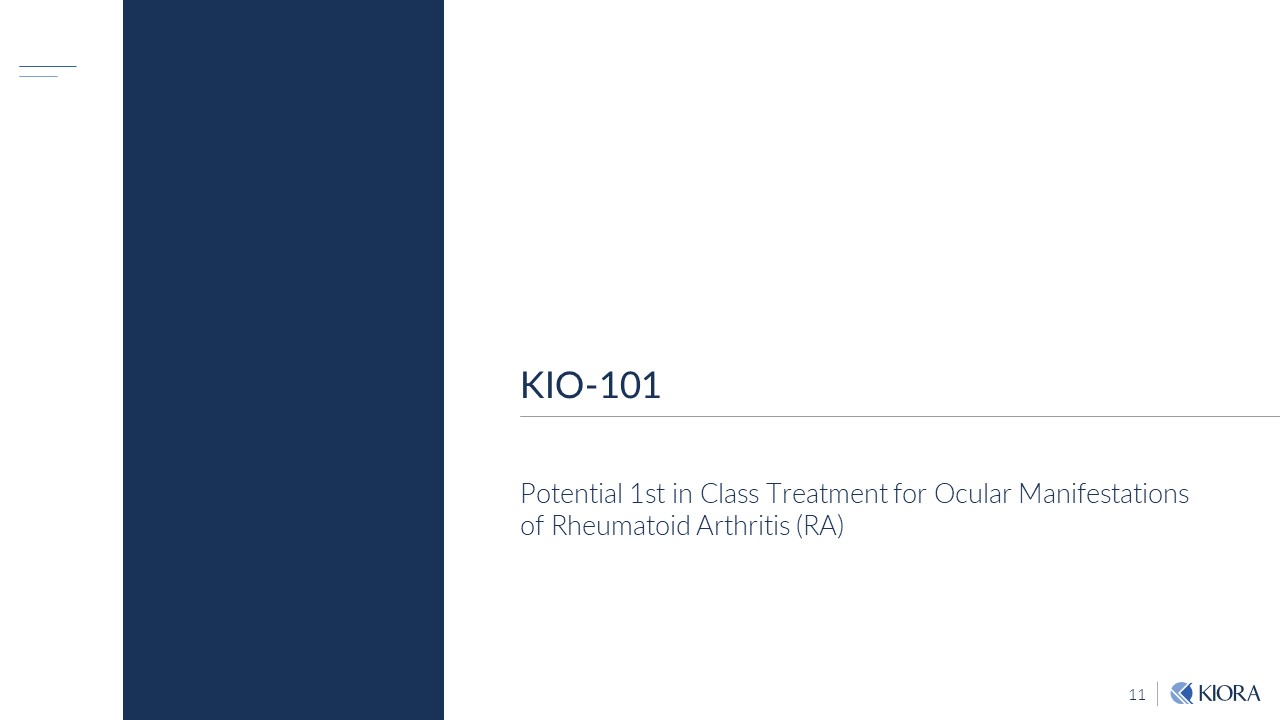
11 KIO - 101 Potential 1st in Class Treatment for Ocular Manifestations of Rheumatoid Arthritis (RA)
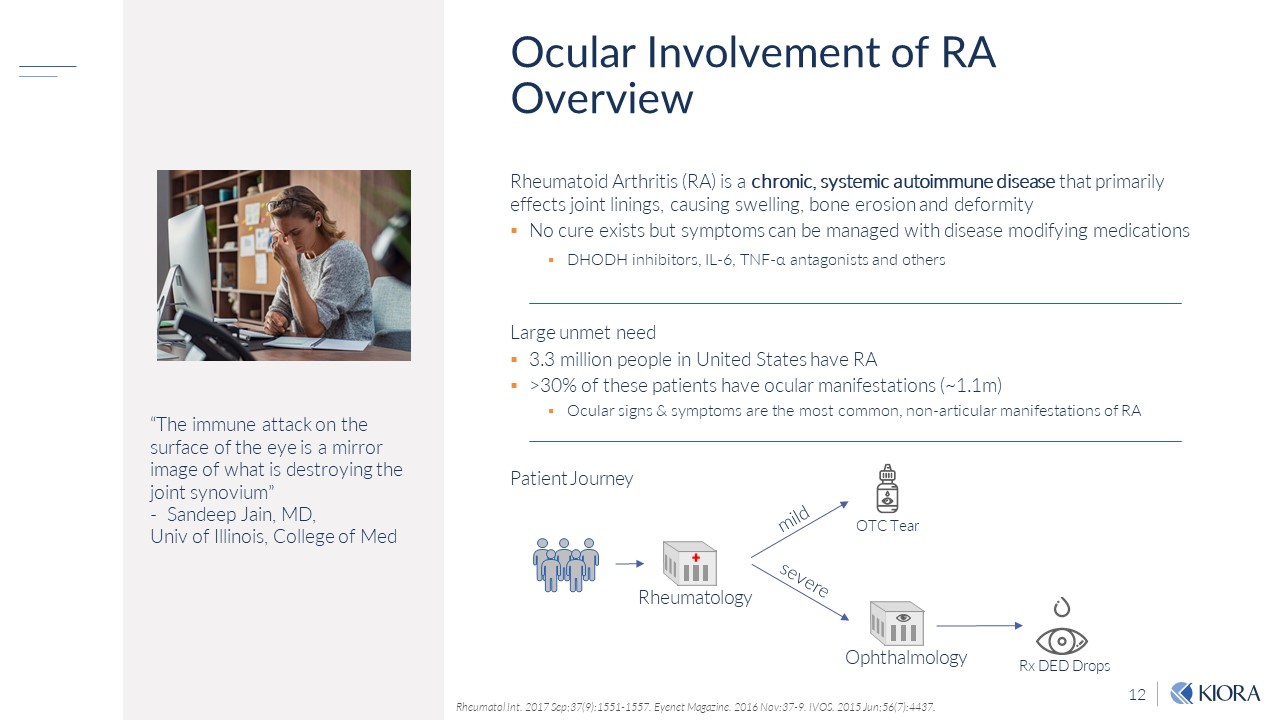
12 Ocular Involvement of RA Overview Large unmet need ▪ 3.3 million people in United States have RA ▪ >30% of these patients have ocular manifestations (~1.1m) ▪ Ocular signs & symptoms are the most common, non - articular manifestations of RA Patient Journey Rheumatoid Arthritis (RA) is a chronic, systemic autoimmune disease that primarily effects joint linings, causing swelling, bone erosion and deformity ▪ No cure exists but symptoms can be managed with disease modifying medications ▪ DHODH inhibitors, IL - 6, TNF - α antagonists and others Rheumatol Int. 2017 Sep;37(9):1551 - 1557. Eyenet Magazine. 2016 Nov:37 - 9. IVOS . 2015 Jun;56(7):4437. “The immune attack on the surface of the eye is a mirror image of what is destroying the joint synovium” - Sandeep Jain, MD, Univ of Illinois, College of Med Rheumatology Ophthalmology OTC Tear Rx DED Drops
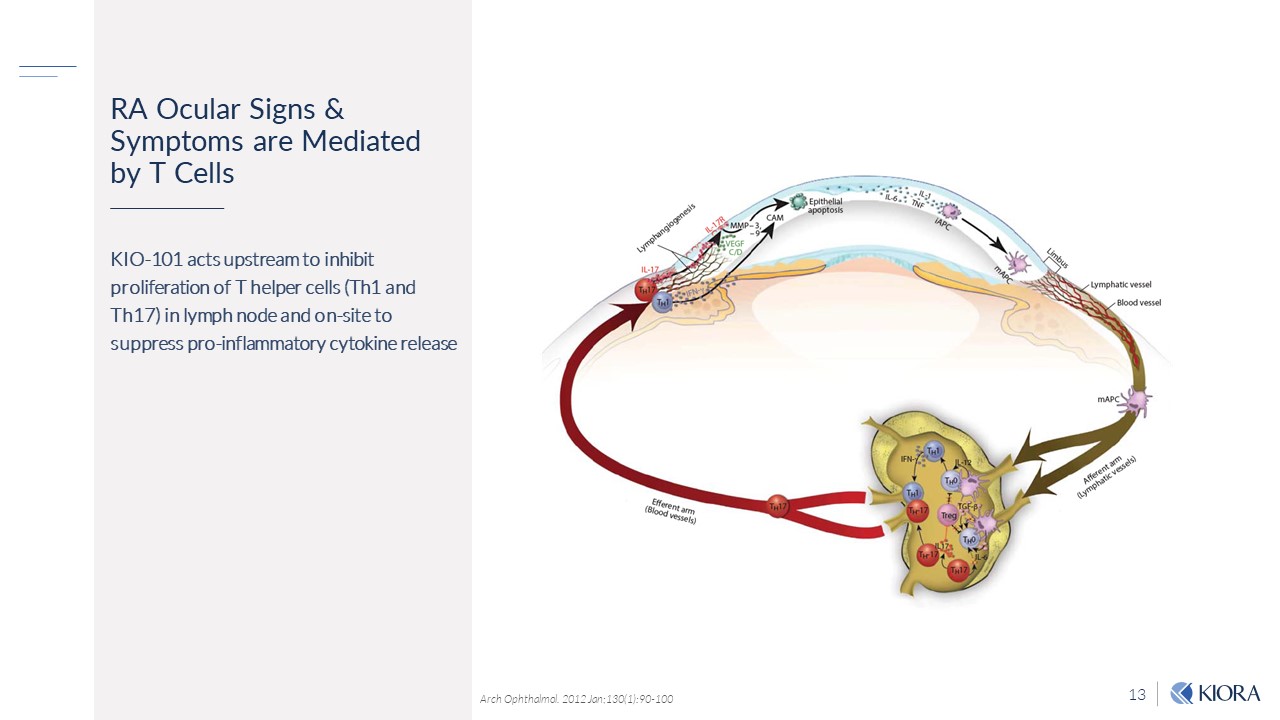
13 RA Ocular Signs & Symptoms are Mediated by T Cells KIO - 101 acts upstream to inhibit proliferation of T helper cells (Th1 and Th17) in lymph node and on - site to suppress pro - inflammatory cytokine release Arch Ophthalmol . 2012 Jan;130(1):90 - 100
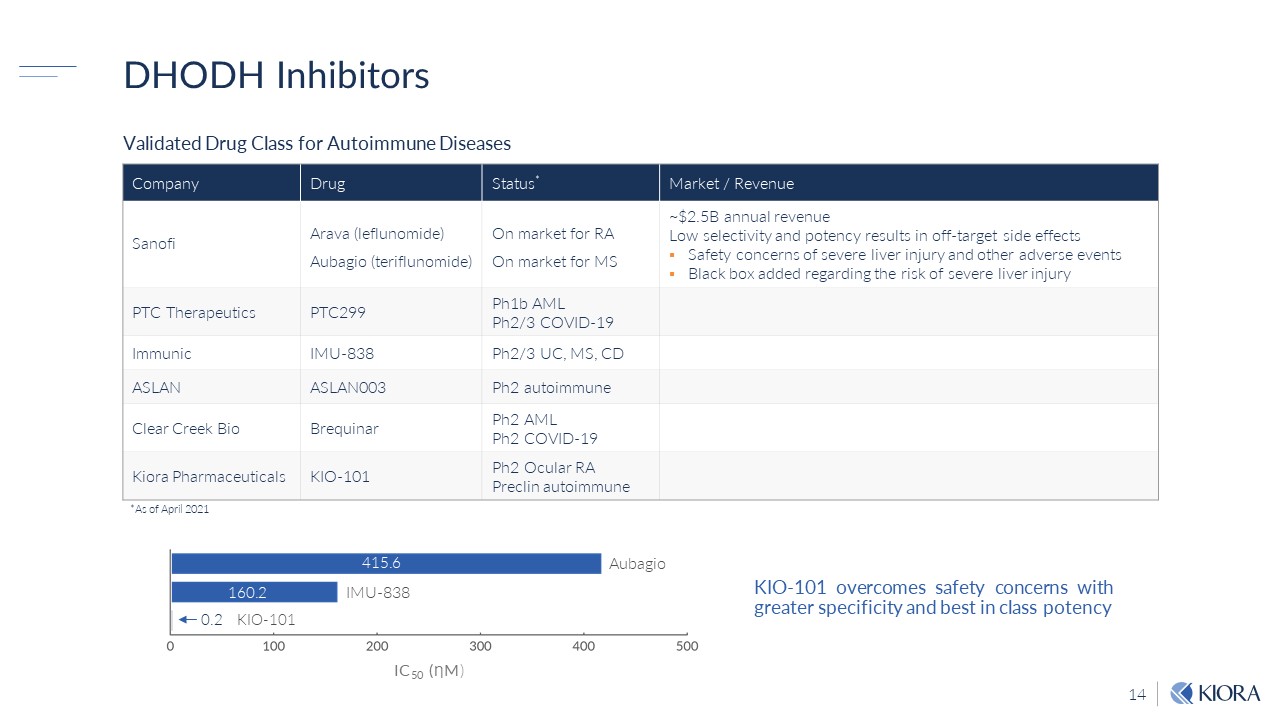
14 Company Drug Status * Market / Revenue Sanofi Arava (leflunomide) Aubagio (teriflunomide) On market for RA On market for MS ~$2.5B annual revenue Low selectivity and potency results in off - target side effects ▪ Safety concerns of severe liver injury and other adverse events ▪ Black box added regarding the risk of severe liver injury PTC Therapeutics PTC299 Ph1b AML Ph2/3 COVID - 19 Immunic IMU - 838 Ph2/3 UC, MS, CD ASLAN ASLAN003 Ph2 autoimmune Clear Creek Bio Brequinar Ph2 AML Ph2 COVID - 19 Kiora Pharmaceuticals KIO - 101 Ph2 Ocular RA Preclin autoimmune DHODH Inhibitors *As of April 2021 Validated Drug Class for Autoimmune Diseases KIO - 101 overcomes safety concerns with greater specificity and best in class potency Aubagio IMU - 838 415.6 160.2 IC 50 ( Ƞ M ) 0.2 KIO - 101
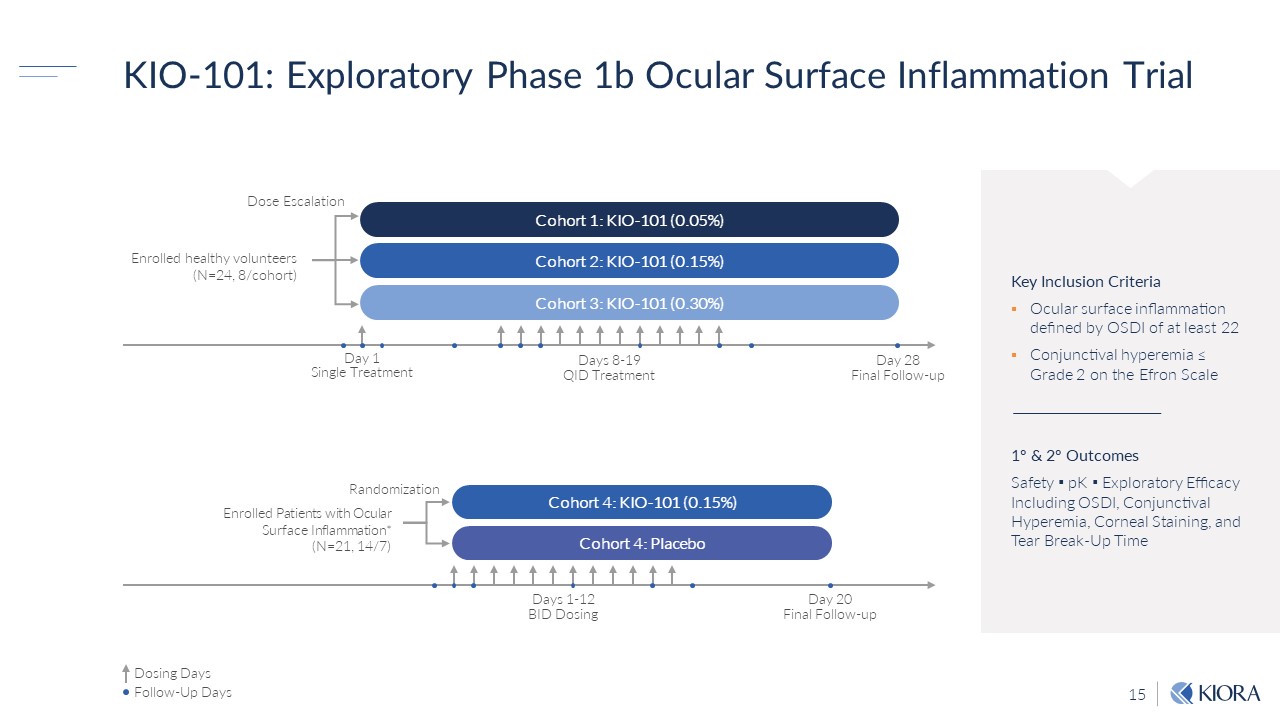
15 KIO - 101: Exploratory Phase 1b Ocular Surface Inflammation Trial Enrolled Patients w ith Ocular Surface Inflammation* (N=21, 14/7) Randomization Days 1 - 12 BID Dosing Day 20 Final Follow - up Cohort 4: KIO - 101 (0.15%) Cohort 4: Placebo Enrolled healthy volunteer s (N=24, 8/cohort) Dose Escalation Day 28 Final Follow - up Cohort 1: KIO - 101 (0.05%) Cohort 2: KIO - 101 (0.15%) Day 1 Single Treatment Days 8 - 19 QID Treatment Cohort 3: KIO - 101 (0.30%) Dosing Days Follow - Up Days ;m1Ѵvbomub|;ub- 1Ѵ-uvu=-1;bmY-ll-ঞom 7;Cm;70" o=-|Ѵ;-v| ƑƑ omfm1ঞ-Ѵ_r;u;lb- ƽ u-7; Ƒ om|_; =uom "1-Ѵ; Ɛ ş Ƒ |1ol;v "-=;| ռ r ռ rѴou-|ouL1-1 m1Ѵ7bm]" ķomfm1ঞ-Ѵ r;u;lb-ķoum;-Ѵ"|-bmbm]ķ-m7 $;-uu;-h Ŋ &r$bl;
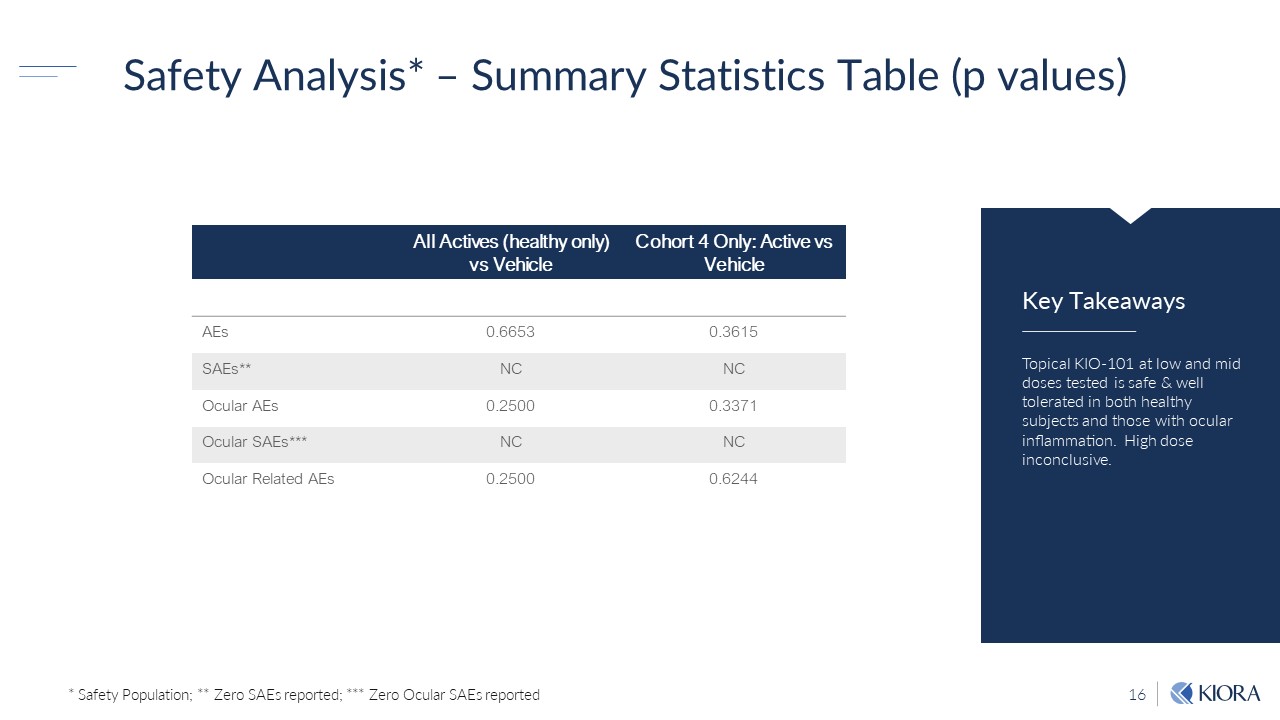
16 Key Takeaways Safety Analysis* – Summary Statistics Table (p values) $orb1-Ѵ Ŋ ƐƏƐ -|Ѵo-m7lb7 7ov;v|;v|;7bvv-=;ş;ѴѴ |oѴ;u-|;7bm0o|__;-Ѵ|_ v0f;1|v-m7|_ov;b|_o1Ѵ-u bmY-ll-ঞomĺb]_7ov; bm1om1Ѵvb;ĺ * Safety Population; ** Zero SAEs reported; *** Zero Ocular SAEs reported All Actives (healthy only) vs Vehicle Cohort 4 Only: Active vs Vehicle AEs 0.6653 0.3615 SAEs** NC NC Ocular AEs 0.2500 0.3371 Ocular SAEs*** NC NC Ocular Related AEs 0.2500 0.6244
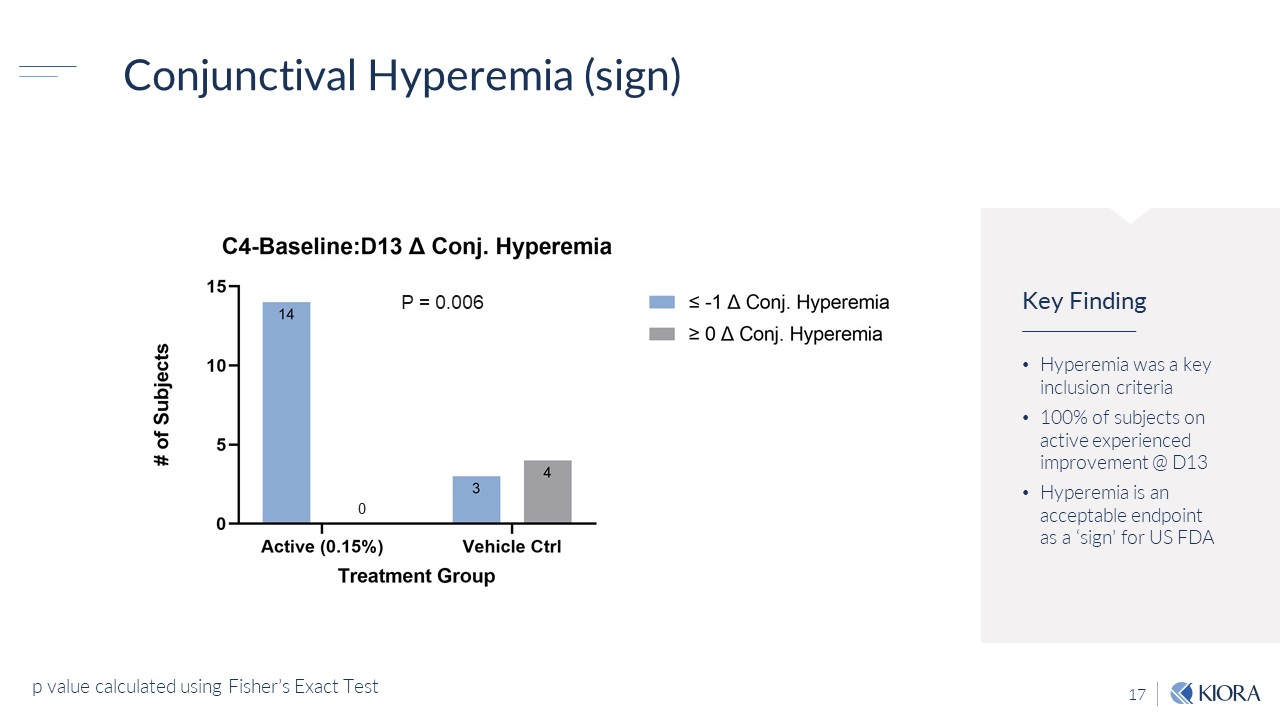
17 Key Finding • Hyperemia was a key inclusion criteria • 100% of subjects on active experienced improvement @ D13 • Hyperemia is an acceptable endpoint as a ‘sign’ for US FDA Conjunctival Hyperemia (sign) p value calculated using Fisher’s Exact Test 0 3
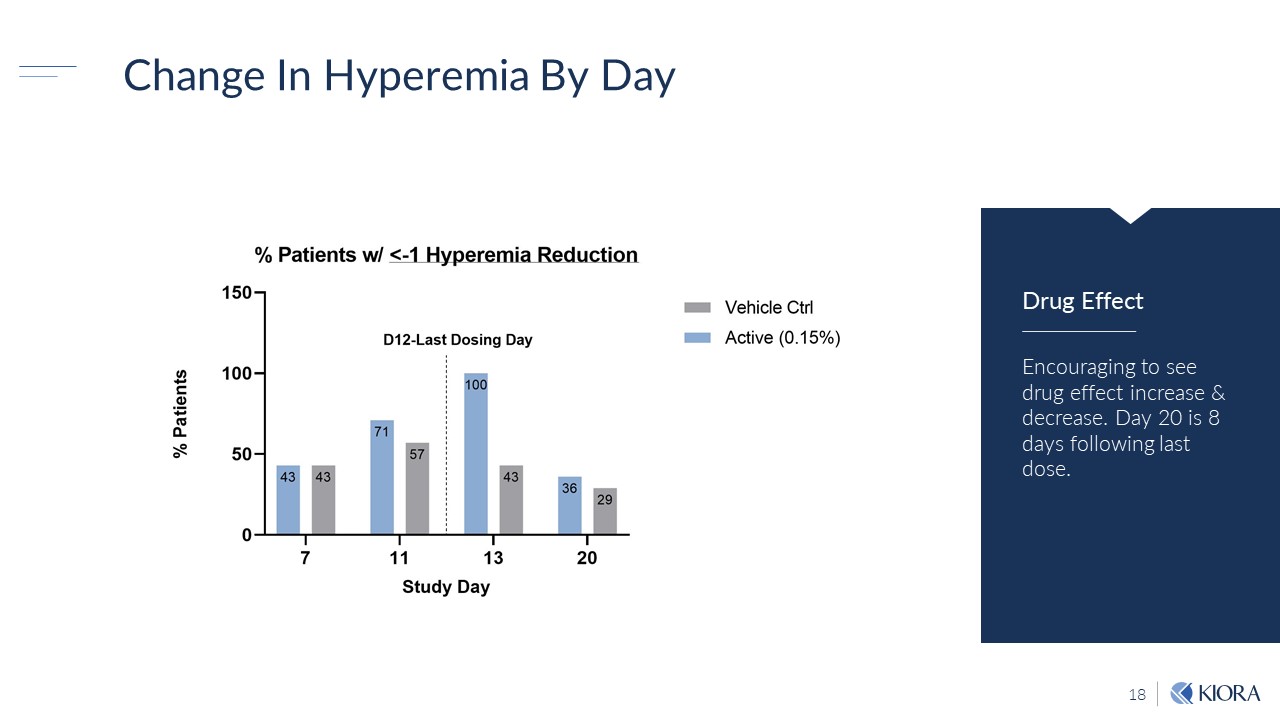
18 Drug Effect Change In Hyperemia By Day Encouraging to see drug effect increase & decrease. Day 20 is 8 days following last dose.

19 Top - Line Data: OSDI • Inclusion criteria was OSDI > 22 • OSDI measured @ screen & D11 • Active demonstrated small trend toward significance
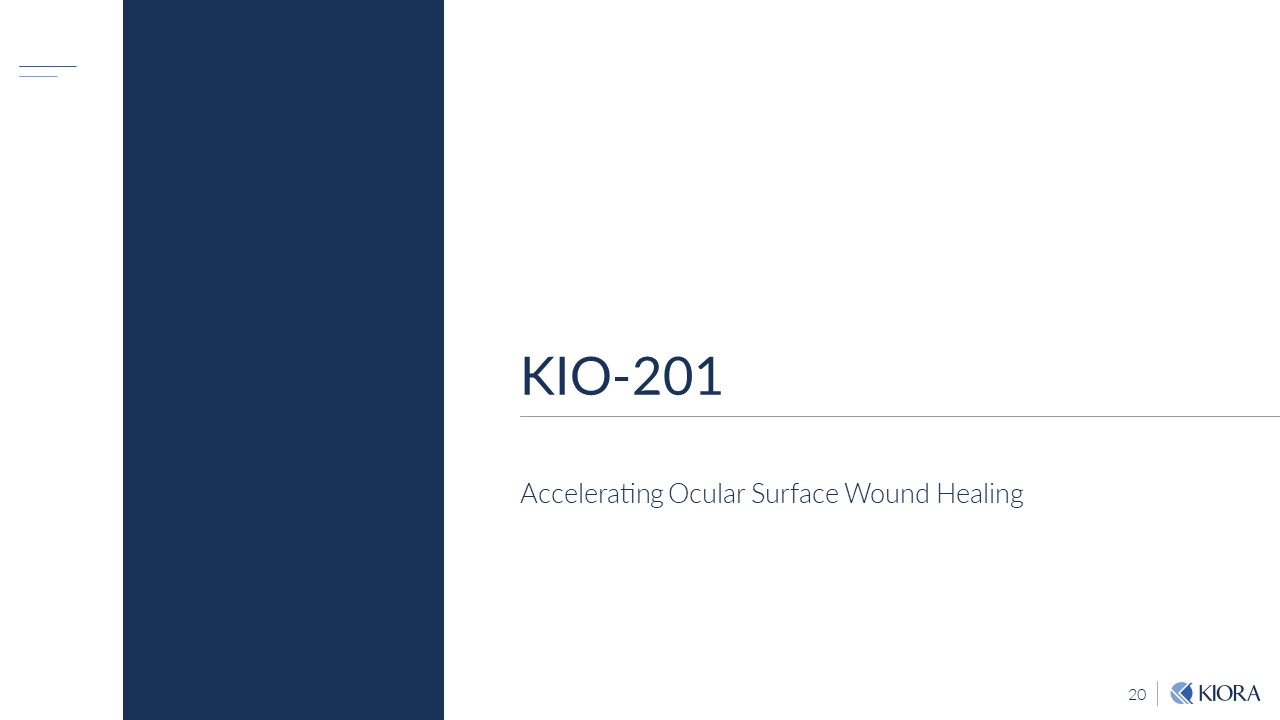
20 KIO - 201 11;Ѵ;u-ঞm]1Ѵ-u"u=-1;)om7;-Ѵbm]
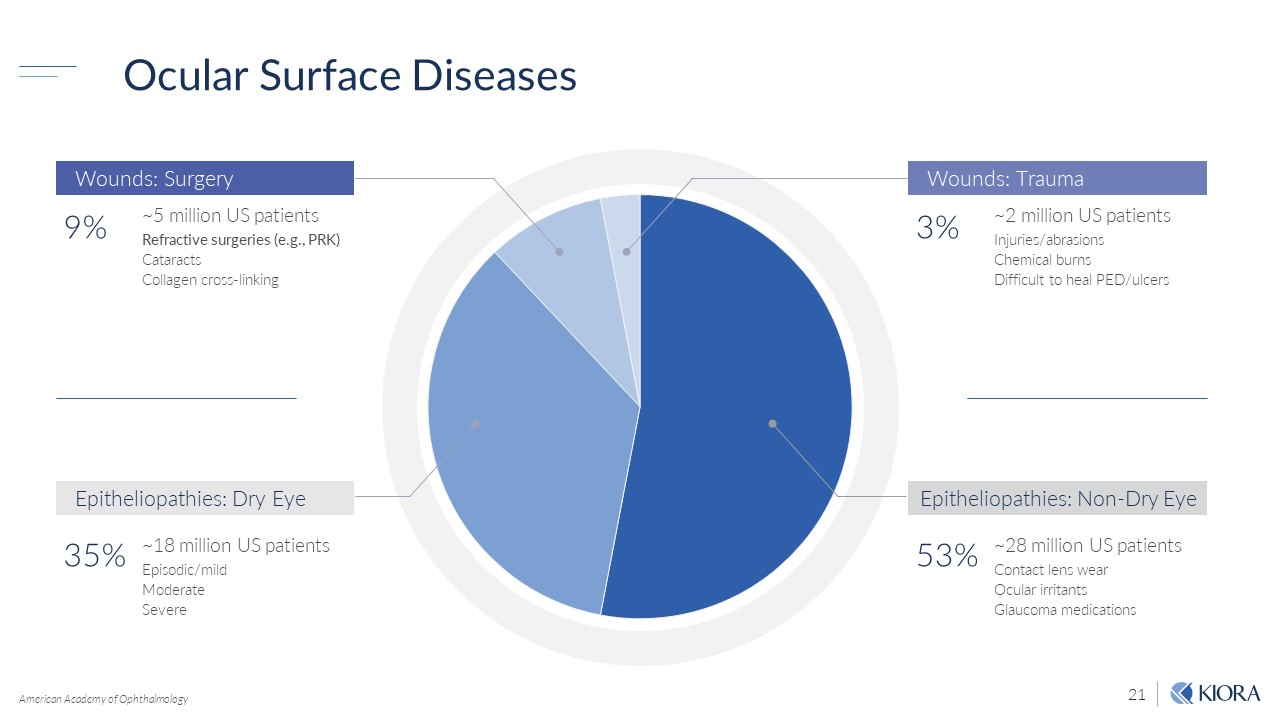
21 Ocular Surface Diseases American Academy of Ophthalmology ~5 million US patients Refractive surgeries (e.g., PRK) Cataracts Collagen cross - linking 9% Wounds: Surgery ~18 million US patients Episodic/mild Moderate Severe ƒƔ ѷ Epitheliopathies: Dry Eye ~2 million US patients Injuries/abrasions Chemical burns Difficult to heal PED/ulcers 3% Wounds: Trauma ~28 million US patients Contact lens wear Ocular irritants Glaucoma medications 53% Epitheliopathies: Non - Dry Eye
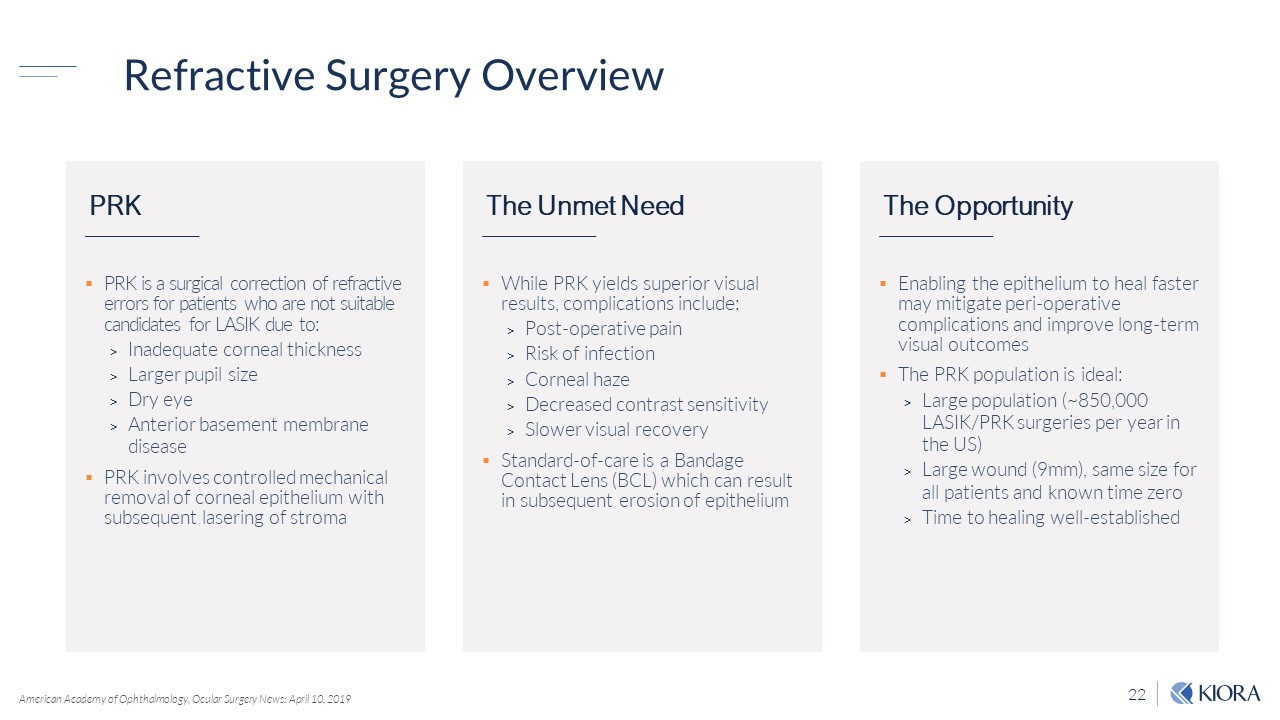
ƑƑ Refractive Surgery Overview American Academy of Ophthalmology, Ocular Surgery News: April 10, 2019 ▪ PRK is a surgical correction of refractive errors for patients who are not suitable candidates for LASIK due to: > Inadequate corneal thickness > Larger pupil size > Dry eye > Anterior basement membrane disease ▪ PRK involves controlled mechanical removal of corneal epithelium with subsequent lasering of stroma ▪ While PRK yields superior visual results, complications include: > Post - operative pain > Risk of infection > Corneal haze > Decreased contrast sensitivity > Slower visual recovery ▪ Standard - of - care is a Bandage Contact Lens (BCL) which can result in subsequent erosion of epithelium ▪ Enabling the epithelium to heal faster may mitigate peri - operative complications and improve long - term visual outcomes ▪ The PRK population is ideal: > Large population (~850,000 LASIK/PRK surgeries per year in the US) > Large wound (9mm), same size for all patients and known time zero > Time to healing well - established PRK The Unmet Need 7KH2SSRUWXQLW\
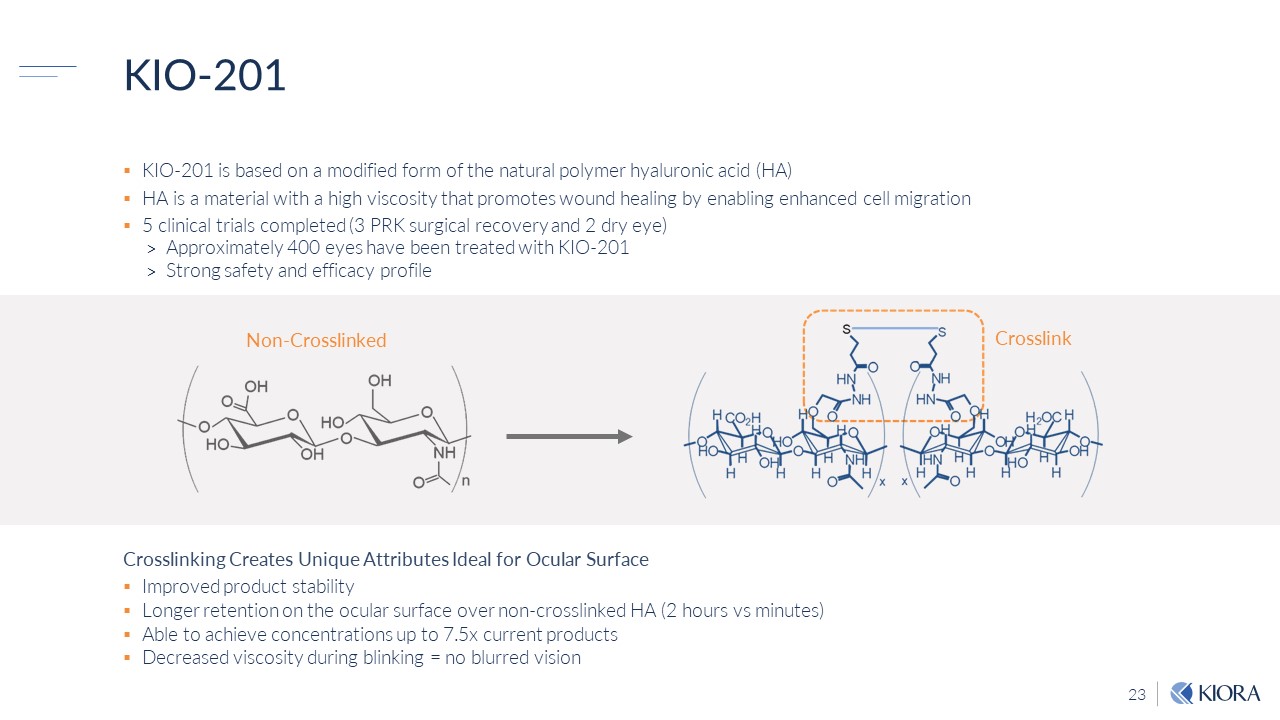
23 KIO - 201 ▪ KIO - 201 is based on a modified form of the natural polymer hyaluronic acid (HA) ▪ HA is a material with a high viscosity that promotes wound healing by enabling enhanced cell migration ▪ 5 clinical trials completed (3 PRK surgical recovery and 2 dry eye) > Approximately 400 eyes have been treated with KIO - 201 > Strong safety and efficacy profile Crosslinking Creates Unique Attributes Ideal for Ocular Surface ▪ Improved product stability ▪ Longer retention on the ocular surface over non - crosslinked HA (2 hours vs minutes) ▪ Able to achieve concentrations up to 7.5x current products ▪ Decreased viscosity during blinking = no blurred vision Non - Crosslinked Crosslink
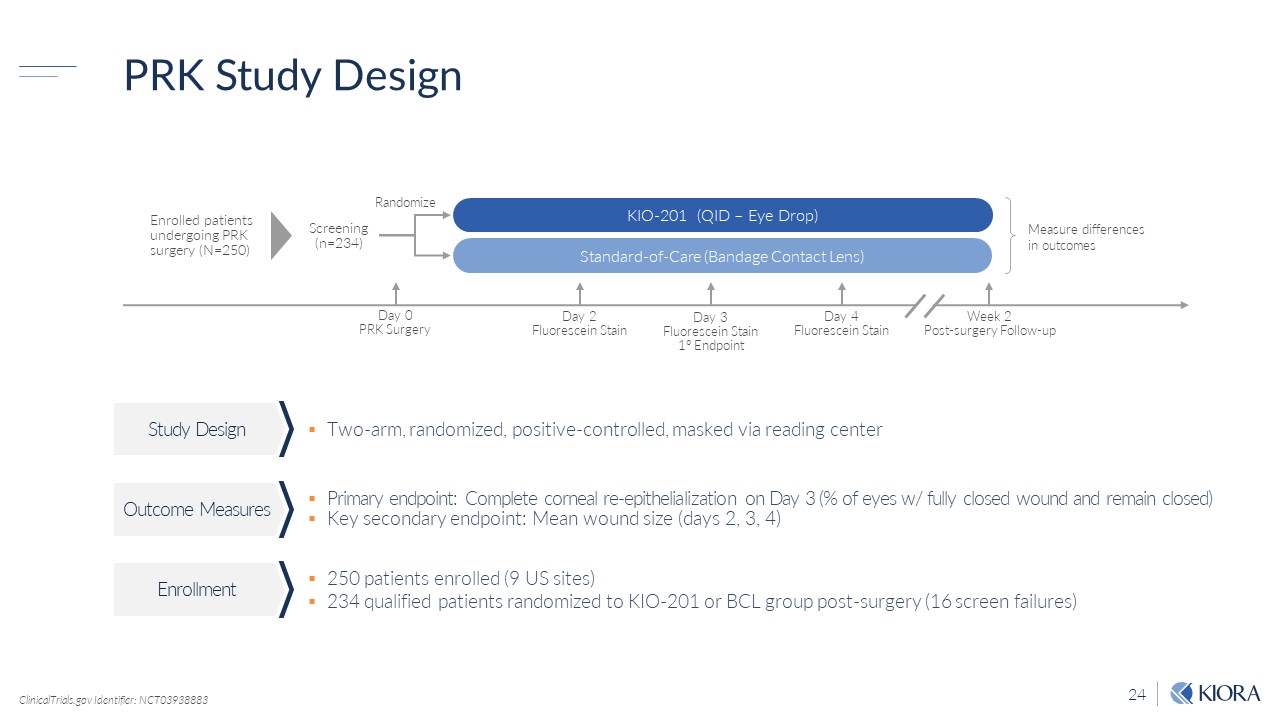
24 !"|7 ;vb]m ClinicalTrials.gov Identifier: NCT03938883 Enrolled patients undergoing PRK surgery (N=250) Day 0 PRK Surgery Week 2 Post - surgery Follow - up Measure differences in outcomes Screening (n=234) KIO - 201 (QID – Eye Drop) "|-m7-u7 Ŋ o= Ŋ -u;Ő-m7-];om|-1|;mvő Randomize Day 2 Fluorescein Stain Day 3 F luorescein Stain 1º Endpoint Day 4 F luorescein Stain ▪ Two - arm, randomized, positive - controlled, masked via reading center ▪ Primary endpoint: Complete corneal re - epithelialization on Day 3 (% of eyes w/ fully closed wound and remain closed) ▪ Key secondary endpoint: Mean wound size (days 2, 3, 4) ▪ 250 patients enrolled (9 US sites) ▪ 234 qualified patients randomized to KIO - 201 or BCL group post - surgery (16 screen failures) "|7 ;vb]m Outcome Measures Enrollment
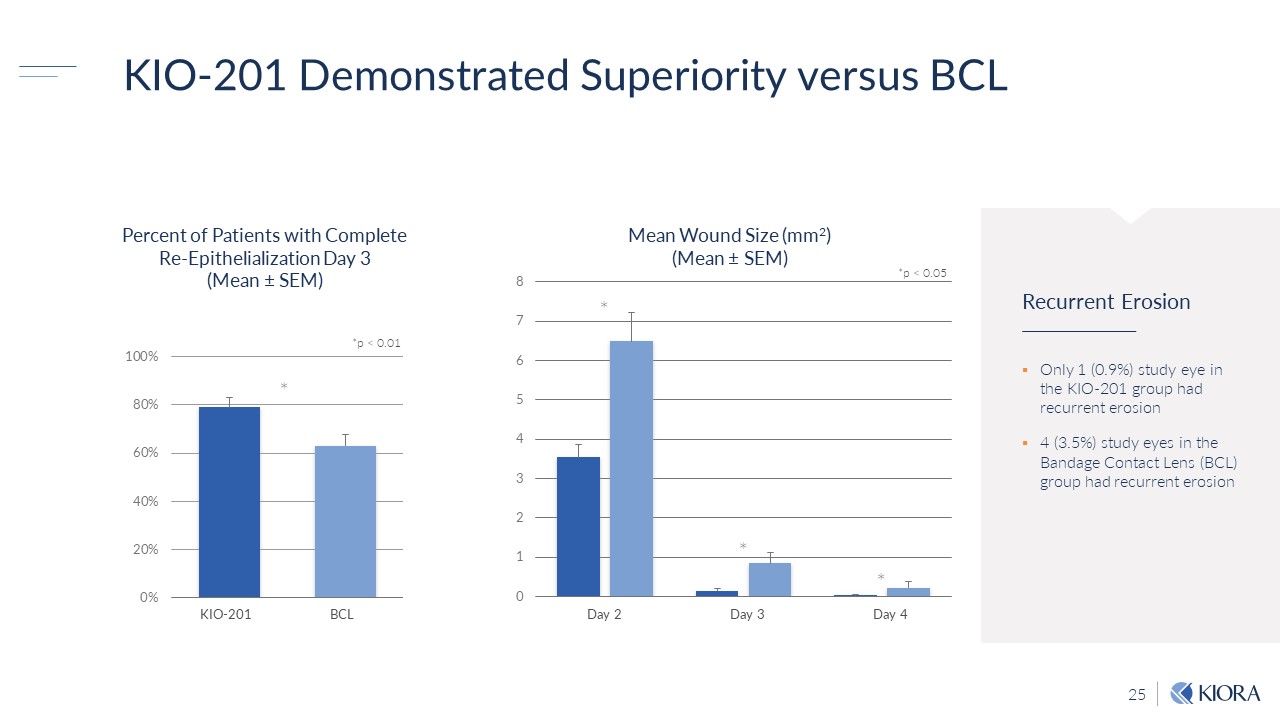
25 Recurrent Erosion ▪ Only 1 (0.9%) study eye in the KIO - 201 group had recurrent erosion ▪ 4 (3.5%) study eyes in the Bandage Contact Lens (BCL) group had recurrent erosion KIO - 201 Demonstrated Superiority versus BCL Percent of Patients with Complete Re - Epithelialization Day 3 (Mean ± SEM) ;-m)om7"b;Őll Ƒ ő Ő;-m Ƽ "ő 0 1 2 3 4 5 6 7 8 Day 2 Day 3 Day 4 Day 2 Day 3 Day 4 *p < 0.05 * * * 0% 20% 40% 60% 80% 100% OBG BCL Ŗrƺ ƏĺƏƐ KIO - 201 BCL *
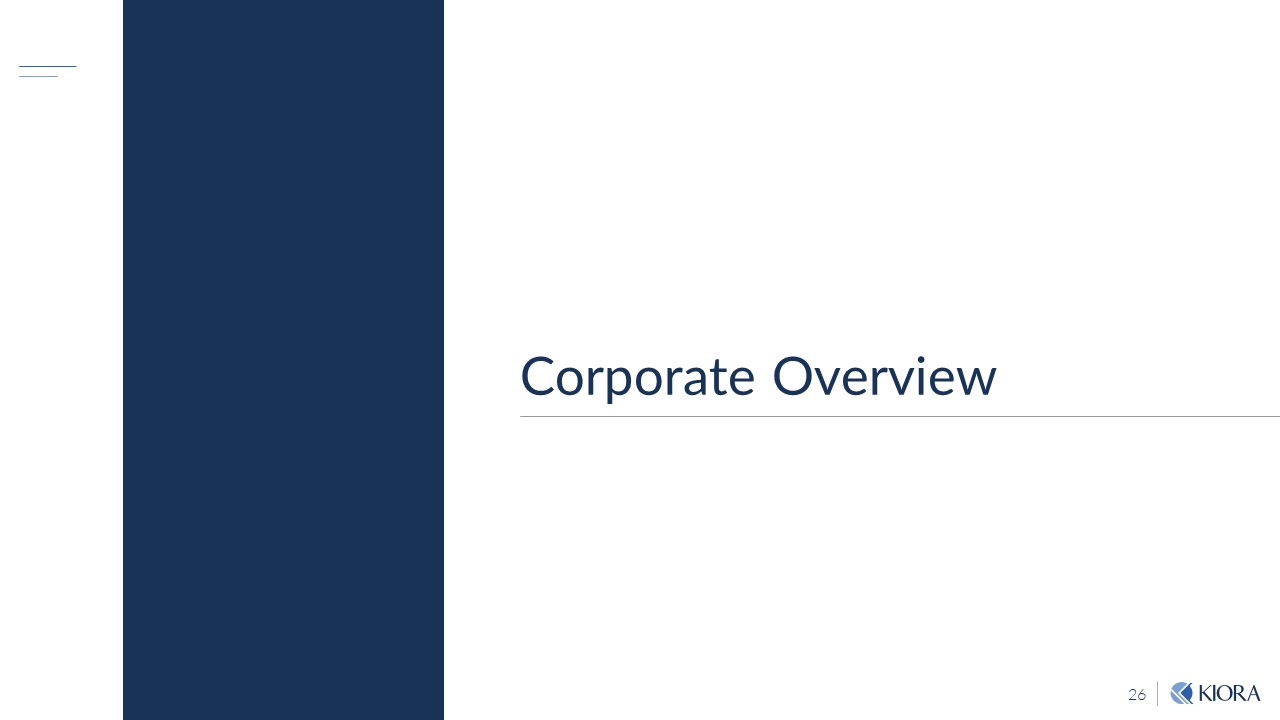
26 Corporate Overview
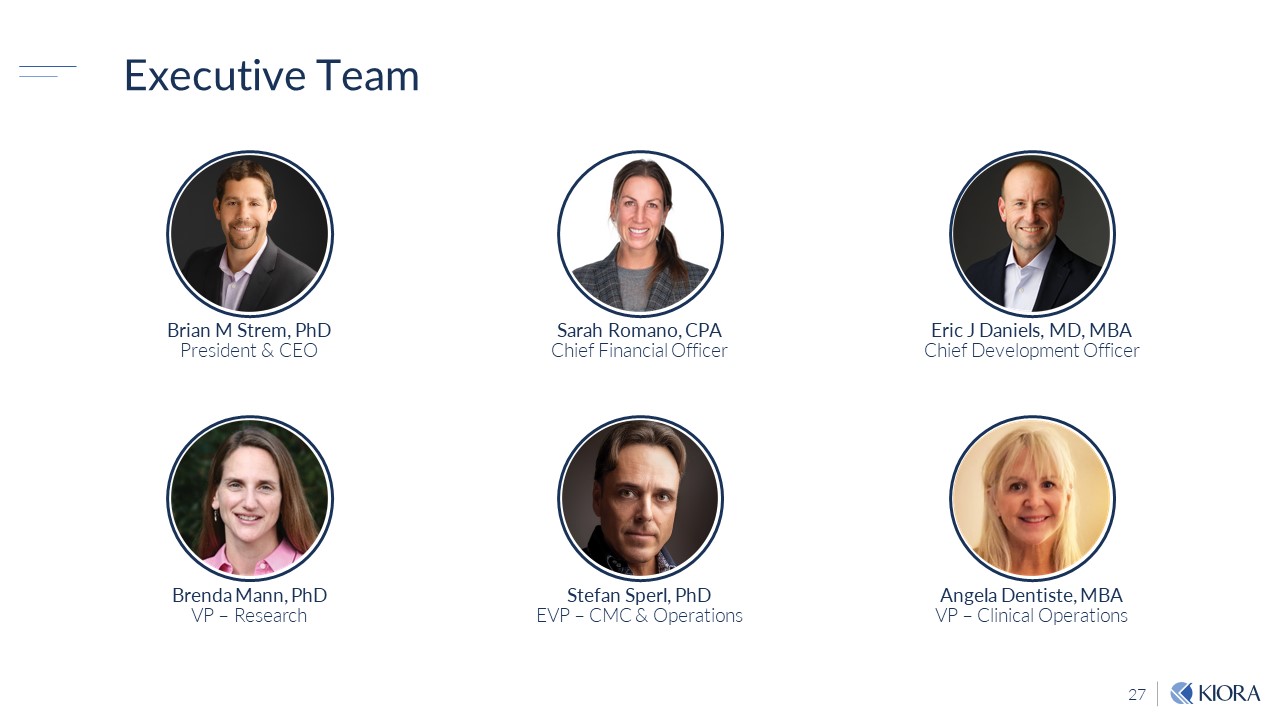
27 Executive Team Brian M Strem, PhD President & CEO u;m7--mmķ_ ( ŋ !;v;-u1_ Sarah Romano, CPA Chief Financial Officer Stefan Sperl, PhD EVP – CMC & Operations Eric J Daniels, MD, MBA Chief Development Officer Angela Dentiste, MBA VP – Clinical Operations

28 Board of Directors Stephen From Executive Chairman ub-m"|u;lķ_ u;vb7;m|ş Paul Chaney Lead Independent Director Aron Shapiro Ken Gayron Praveen Tyle David Hollander, MD, MBA
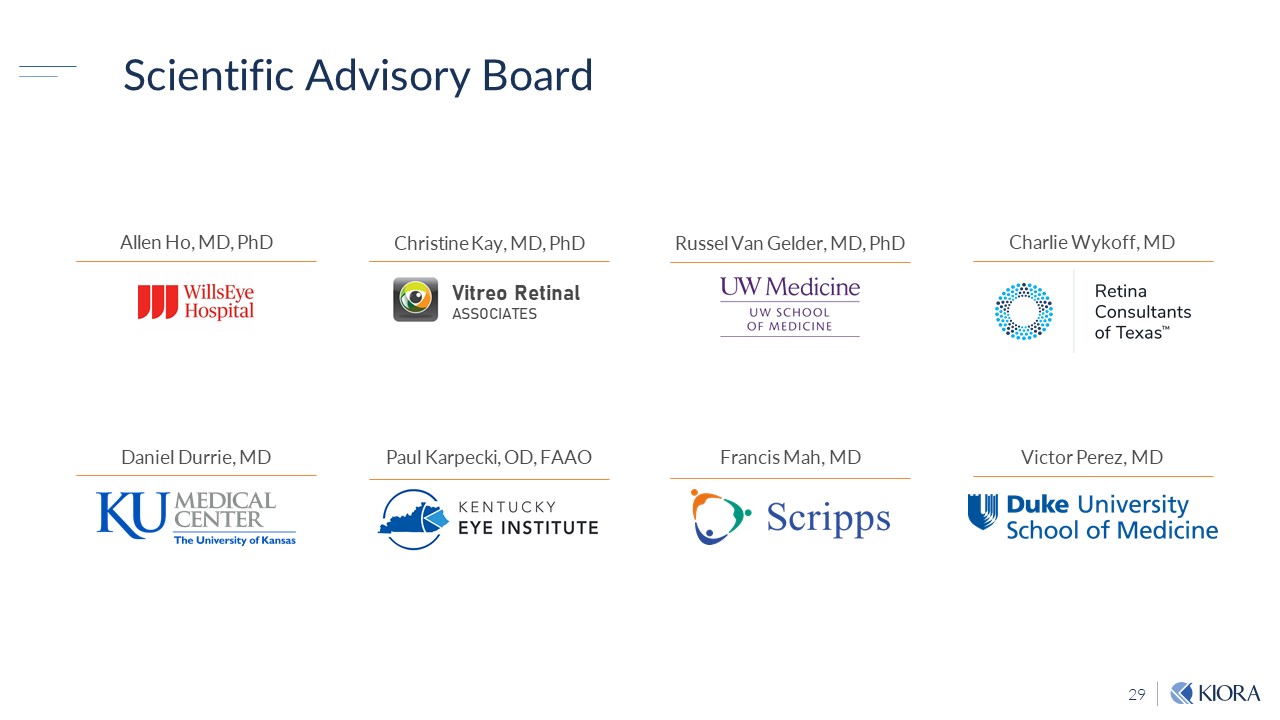
29 Scientific Advisory Board -mb;Ѵ uub;ķ Russel Van Gelder, MD, PhD Charlie Wykoff, MD Victor Perez, MD Francis Mah, MD Paul Karpecki, OD, FAAO Allen Ho, MD, PhD Christine Kay, MD, PhD t¯ãØÈ Yã¯Â¼ ]]I0d]
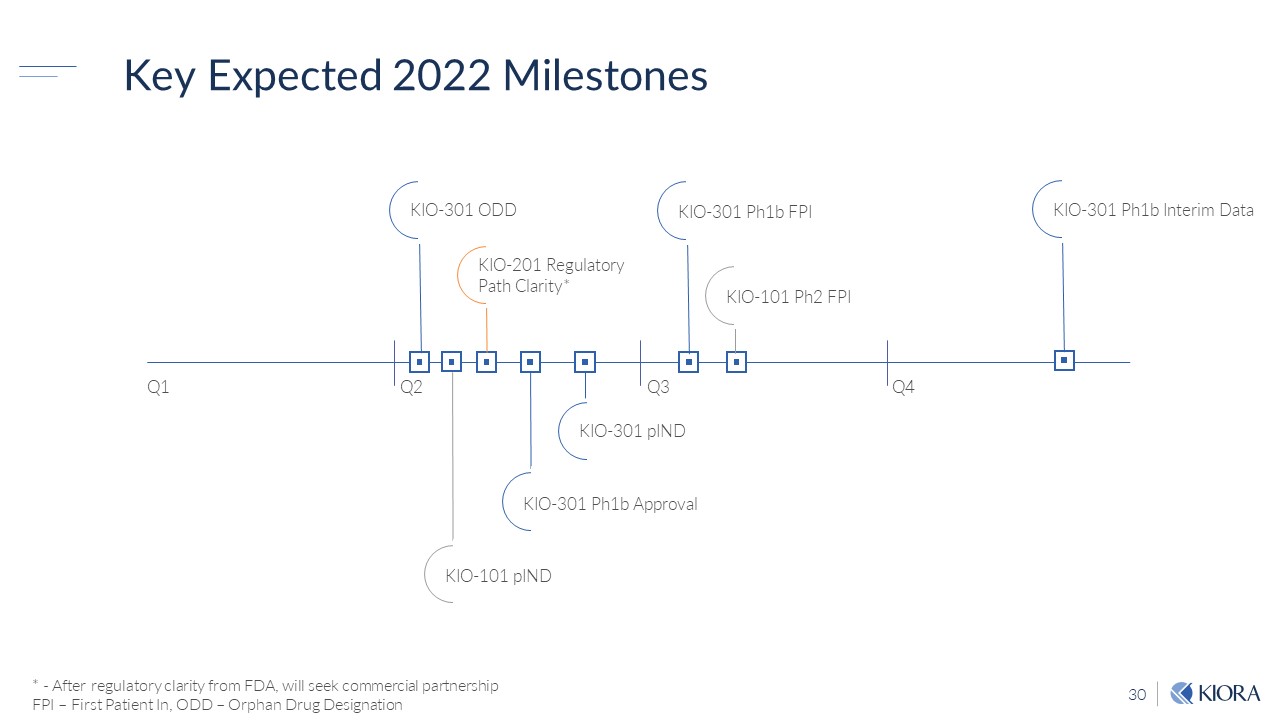
30 Key Expected 2022 Milestones KIO - 301 ODD KIO - 201 Regulatory Path Clarity* KIO - 301 Ph1b Approval KIO - 301 pIND * - After regulatory clarity from FDA, will seek commercial partnership FPI – First Patient In, ODD – Orphan Drug Designation Ŋ ƒƏƐ _ Ɛ 0 KIO - 101 Ph2 FPI Q1 Q2 Q3 Q4 KIO - 301 Ph1b Interim Data KIO - 101 pIND

om|-1|Ĺ bm=oŠhbou-r_-ul-ĺ1ol